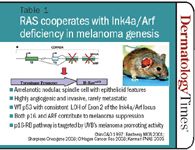- General Dermatology
- Eczema
- Chronic Hand Eczema
- Alopecia
- Aesthetics
- Vitiligo
- COVID-19
- Actinic Keratosis
- Precision Medicine and Biologics
- Rare Disease
- Wound Care
- Rosacea
- Psoriasis
- Psoriatic Arthritis
- Atopic Dermatitis
- Melasma
- NP and PA
- Skin Cancer
- Hidradenitis Suppurativa
- Drug Watch
- Pigmentary Disorders
- Acne
- Pediatric Dermatology
- Practice Management
- Prurigo Nodularis
Article
Mouse model helps target cancer genes
Advances in genome-scanning technology, coupled with the human genome sequence, allow researchers to pinpoint candidate genes that are altered in the cancer.
Reston, Va. - Genetically engineered mice that model key features of human cancer can be helpful in narrowing the search for the genetic origins of cancer, according to a leading researcher.

"What we've found in looking at 120 human melanomas and cell lines is that there are more than 150 regions of recurrent amplifications or deletions. We assume that in at least half of those regions, true cancer-relevant genes are being targeted," Dr. Chin tells Dermatology Times. "Thus, many more candidate melanoma-relevant genes remain to be discovered."
However, given the complexity of the melanoma genome and the large number of candidates requiring detailed analyses, Dr. Chin says translating new genomic insights into something that helps patients - such as identifying a drug development target and delivering a drug to patients - remains a lengthy process.
"To have any hope of potentially accelerating that process," she says, "Creative ways of prioritizing our efforts are needed, because there are so many choices to work on."

Dr. Chin explains, "We can engineer key mutations that have been identified and validated in human melanoma, such as inactivation of the melanoma suppressor CDKN2a locus on 9p21, and activation of RAS or BRAF, into the mouse."
By combining different strains carrying various engineered alleles, she says one can develop a GEM that is prone to developing melanoma.
"But chances are, those engineered mutations together are still not sufficient to transform the melanocyte. By the time melanoma develops in the mouse, we can document, and others have shown, that additional genetic alterations that cooperated with the engineered mutations have been acquired (Bardeesy N et al. Mol Cell Biol. 2001 Mar;21(6):2144-2153.)," Dr. Chin says.







